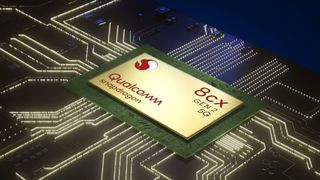Qualcomm announces new Snapdragon 8cx Gen 2 5G Compute Platform, ships 'late 2020'
Qualcomm's revision to its Snapdragon 8cx brings 5G, Wi-Fi 6, and a dash of better performance later this year.

What you need to know
- The Snapdragon 8cx Gen 2 5G is coming late 2020.
- Snapdragon 8cx Gen 2 brings improved performance, 5G, and Wi-Fi 6.
- Acer is the first to launch with 8cx Gen 2 with its new Spin 7 laptop with 5G.
Berlin, Germany – September 3, 2020 – Qualcomm is not resting on its Windows on ARM ambitions as the company has announced its revised Snapdragon 8cx Gen 2 5G Compute Platform. The chip is a sequel of sorts to the Snapdragon 8cx found currently in Lenovo Flex 5G, Samsung Galaxy Book S, and modified in Surface Pro X.
The Snapdragon 8cx Gen 2 5G is not a wild alteration that obsoletes the current Snapdragon 8cx, but it does push the platform further with newer technologies, specifically:
- 5G connectivity: Snapdragon 8cx Gen 2 brings both Sub-6 GHz and 5G mmWave, enabling blazing fast, multi-gigabit speed, and stability.
- Wi-Fi 6: This Gen 2 compute platform will offer users the leading connectivity critical to work from virtually anywhere and help alleviate home networks congested by multiple connected devices.
- Improved performance: Snapdragon 8cx Gen brings "more performance" and "higher efficiency" than the previous generation.
- Audio: Qualcomm Aqstic echo cancellation and noise suppression (ECNS) technology to intelligently focus on the sounds coming from the PC and the user's environment.
There is also the usual line about "AI", specifically how Qualcomm's AI Engine lets users "experience stronger video conferencing interactions through tools such as accelerated eye contact and expressive avatars." Such a technology recently came to Surface Pro X through its "Eye Contact" feature, which adjusts your eyes, so it looks as if you're are looking into the camera and not your display.
Wi-Fi 6 was sorely missing from recent Windows on ARM PCs, so that is a great feature to see.
Although 5G is a lot of hype right now and hard to find, when you can, it is a very fast experience. Lenovo's Flex 5G already had 5G (but no Wi-Fi 6), and it is currently offered through Verizon in the United States. That device was an exception to Snapdragon 8cx, whereas 8cx Gen 2 has 5G readily available to all PC makers. However, 5G is an option, so OEMs can still build non-5G laptops to keep costs down and satisfy current markets.

The big question is what, if any, is the increased performance with Snapdragon 8cx Gen 2. Qualcomm is doing some handwaving with "more performance and higher efficiency compared to the previous generation," and the company claims "Snapdragon 8cx Gen 2 5G delivers over 50 percent greater systemwide performance and battery life versus competing solutions", which is doing a lot of heavy lifting. In the chart above, Qualcomm does put it against Intel's 10th Gen Core i5 (15W), which seems promising. It is probably safe to expect a very modest speed boost in Gen 2, but we'll need to find out more later this fall.
Qualcomm is citing "late 2020" as the launch window for Snapdragon 8cx Gen 2, a faster turnaround than usual. Indeed, the first PC that ships is Acer's new Spin 7 - a standard convertible laptop with a siloed active stylus and both flavors of 5G. HP is also expected to have a new Qualcomm PC, although details are currently scarce.
Get the Windows Central Newsletter
All the latest news, reviews, and guides for Windows and Xbox diehards.
Recent rumors have also suggested Microsoft may use this chip to revise its "SQ1" custom processor for a Surface Pro X refresh later this year. If that speculation is accurate, it could lead to the first 5G Surface, which would be exciting.

Daniel Rubino is the Editor-in-chief of Windows Central. He is also the head reviewer, podcast co-host, and analyst. He has been covering Microsoft since 2007, when this site was called WMExperts (and later Windows Phone Central). His interests include Windows, laptops, next-gen computing, and watches. He has been reviewing laptops since 2015 and is particularly fond of 2-in-1 convertibles, ARM processors, new form factors, and thin-and-light PCs. Before all this tech stuff, he worked on a Ph.D. in linguistics, watched people sleep (for medical purposes!), and ran the projectors at movie theaters because it was fun.
